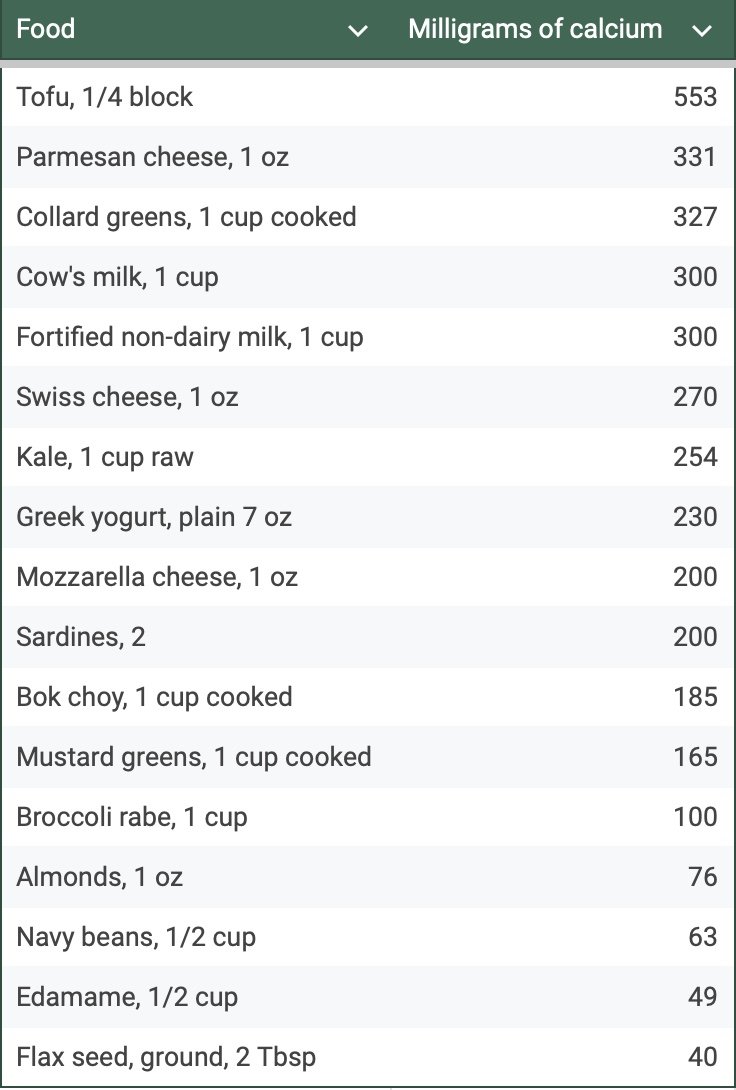Nutrient Spotlight: Foods Rich in Calcium
An Introduction to This Blog Series
Remember looking at the periodic table always stapled to the wall of every science class. A meticulous table filled with all the elements that make up life and matter. I never appreciated the elements in this table as much as I do now recommending diet plans for my patients.
A good quality diet plan considers nutritional interventions specific to each patient’s overall health goals and preferences. As a naturopathic doctor, I advocate for nutritional interventions as a priority to focus on as part of the foundation of a healthy lifestyle. I recommend dietary supplements in situations where patients are working on making those healthy dietary changes, and/or need additional support to address specific symptoms or treat disease.
In human biology, there are essential and non-essential nutrients. Essential nutrients cannot be made by the body, so we need to get them from our diet. Non-essential nutrients can be made by the body as long as it’s healthy and free from metabolic or digestive issues.
This blog will be the start of a blog series where we will share food guides for many different nutrients. I thought we’d start with calcium because one of the most common questions I get asked is, “What are foods rich in calcium”?
Essential elements are required for the body to function properly. They are essential for human life and vitality. The underconsumption of certain nutrients can lead to nutrient deficiencies. Whereas the overconsumption of certain nutrients, more commonly seen with dietary supplements, can also have adverse health effects. It’s important to be mindful of your nutrient consumption overall, including what you eat and what you supplement with on a regular basis.
Each essential mineral has its own unique functions in the body and recommended daily allowance (RDA) of consumption. The RDA represents the amount of each nutrient needed to meet daily nutrient requirements in healthy individuals. When the body is dealing with added stress or disease, nutrients requirements may be more than the RDA.
The highlight of this blog post series is to emphasize food as medicine by sharing examples of foods that contain some of the body’s essential nutrients. If you are looking for specific guidance on nutrition, dietary supplements, or lab testing for nutrient deficiencies, I recommend consulting with a naturopathic doctor.
Calcium is crucial for strengthening bones and teeth, as well as for muscle contraction. The calcium level in your blood, tested on a metabolic panel, is tightly regulated by the body. If your diet lacks adequate calcium, your body will pull calcium from your bones - a smart but risky move! Excessive calcium sequestration from the bones leads to brittleness, a higher risk of fractures, and osteoporosis.
Calcium deposition in the bones requires other nutrients as well, including vitamins C, D, and K2, magnesium, phosphorus, boron, and protein. Adequate levels of these nutrients help with calcium absorption from the intestines and deposition into the bones. Imbalances in any of these nutrients can affect how calcium gets used by the body. For example, without vitamin k2, calcium is more likely to deposit into your artery walls, leading to hardening or calcification, and increasing the risk for cardiovascular disease. This is how calcium supplementation has risks if not done properly.
Women going through menopause are at an increased risk for osteoporosis because of declining hormones levels. Estrogen plays a crucial role in maintaining bone density. Estrogen helps in the absorption and retention of calcium in bones, so its decline during menopause accelerates bone loss. Between menopause and 75 years women lose an average of 22% of their bone mineral density, with the highest rates of loss the year before and the two years after a woman’s last menstrual period. Calcium intake is more critical during the perimenopausal years.
A healthy gut, proper kidney function, adequate intake of essential nutrients, and a well-balanced diet filled with calcium-rich foods will support the absorption and utilization of calcium in the body. Calcium not only helps with bone density, but also heart health, nerve function, and even mood regulation.
Dairy probably comes to mind when you think of calcium-rich foods. But there’s good news for those avoiding dairy—there are plenty of calcium-rich alternatives! Leafy greens, tofu, nuts, and seeds also contain excellent sources of calcium. It’s entirely possible to maintain a calcium-rich, dairy-free diet. So next time you’re meal planning, think beyond dairy and incorporate a variety of calcium-rich foods to keep your bones strong and your body thriving!
The Recommended Daily Allowance (RDA) for calcium varies by age, gender, and life stage. Here are the RDAs for calcium across different age groups:
Infants
0-6 months: 200 mg/day
7-12 months: 260 mg/day
Children
1-3 years: 700 mg/day
4-8 years: 1,000 mg/day
9-18 years: 1,300 mg/day
Adults
19-50 years: 1,000 mg/day
51-70 years (women): 1,200 mg/day
51-70 years (men): 1,000 mg/day
71 years and older: 1,200 mg/day
Pregnant and Lactating Women
1,000-1,300 mg/day
Calcium [Ca2+]
References:
1. United States Department of Agriculture. FoodData Central. U.S. Department of Agriculture, https://fdc.nal.usda.gov/. Accessed Aug. 2024.


